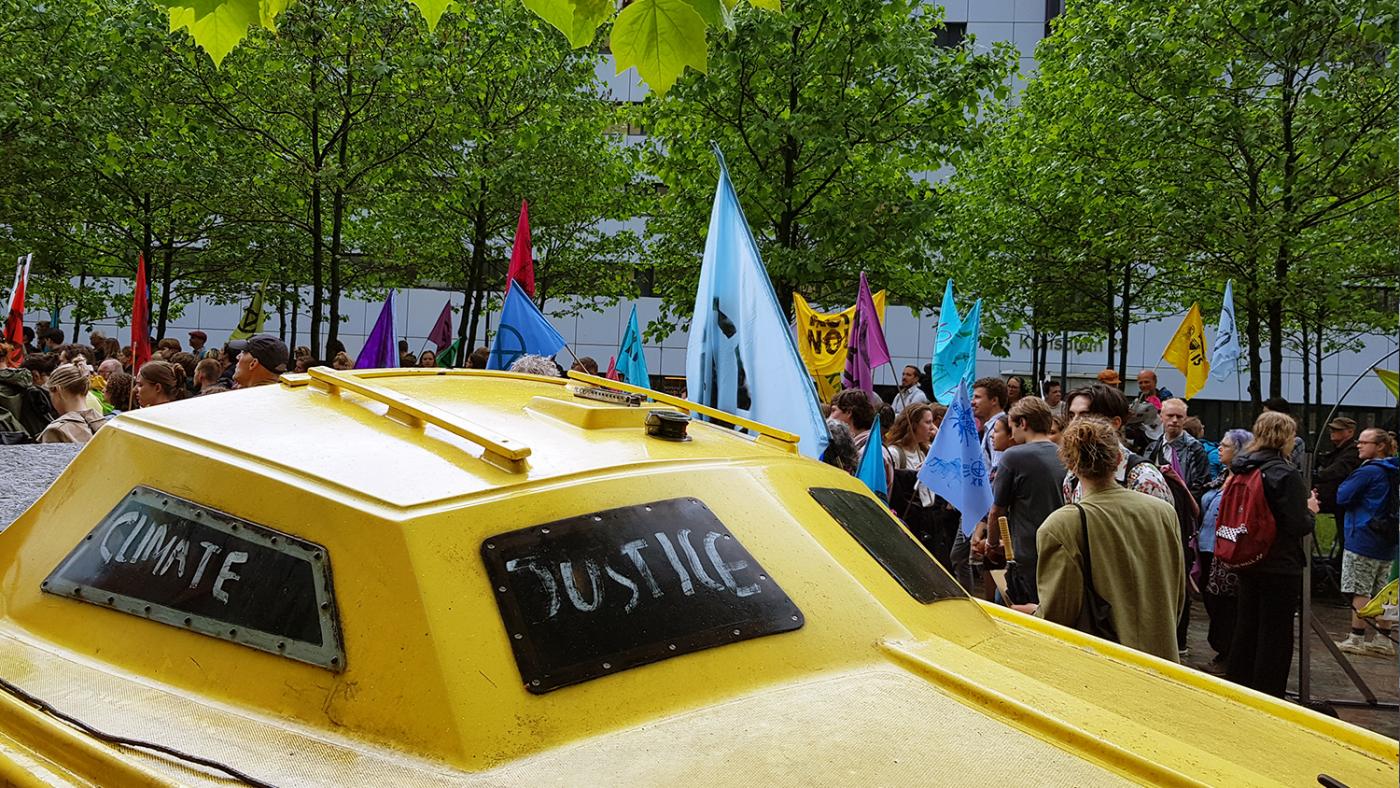UU PhD candidate Amarins Jansma studies activists' motivation
Why young climate rebels glue themselves to the A12 motorway

Later this month, members of the protest group Extinction Rebellion will block the A12 motorway near The Hague once again. Those who wish to participate can attend one of their "protest workshops" organised in several places across the country.
On the one hand, it seems like the young protest movement is gaining more sympathy, with celebrities like Dutch actress Katja Herbers openly declaring their solidarity. The students who recently occupied university buildings in Eindhoven and Rotterdam were also met with sympathy by many.
On the other hand, repulsion and disapproval are also on the rise. A significant number of Dutch citizens have little to no understanding of those they call soup throwers and "climate stickers" (klimaatklevers), people who glue themselves to talk show tables.

Amarins Jansma
PhD candidate Amarins Jansma says that contradiction is exactly what motivated her to study Extinction Rebellion activists for her dissertation. She interviewed 106 people about their motivations.
“The group uses the strategy of civil disobedience, in which people consciously break certain laws and disobey orders. Dutch people have widely varying views on actions of civil disobedience: some people support them, while others think they’re too intense. As a result, the reports in the media about disobedient climate demonstrations vary as well.”
Is it true that a new generation of activists has arisen?
“Climate activism started in the 1970s, after the Limits to Growth report by the Club of Rome. In that report, researchers indicate that the current consumer behaviour is untenable. Since 2017 and 2018, the number of climate activists has grown exponentially. This is the period in which Greta Thunberg became famous. Extinction Rebellion was founded in the UK in 2019 and its Dutch branch was founded in 2019. So, climate activists have been protesting for quite some time but the movement has grown in size these past few years.”
What kind of people tend to participate in this movement?
“It’s clear that young people tend to be much more aware of the climate issue. The subject is being discussed in schools more often and it’s becoming more and more of a hot topic on social media as well. Our future looks less promising than we once thought and young people are worried about it. Many concerned grandparents are also taking part in activism.
Extinction Rebellion members tend to be young and highly educated. Opponents often shout that they ‘need to go find a job but many of them do have good jobs. There are scientists involved in the organisation as well.”
Why do people join Extinction Rebellion?
“There are many reasons but a recurring theme in our research is that people in the movement think the climate crisis is unjust. Our research shows that climate activists are aware that the rich Global North countries are responsible for most CO2 emissions worldwide, while countries in the Global South have to deal with the negative consequences of climate change. Think of the recent climate disaster in Pakistan, which faced major floods.
“So people are realising there is inequality in climate responsibility and climate impact. Aside from that sense of inequality, many activists fear for their own future or that of their children or grandchildren. They also notice that national governments and multinationals aren’t following through on their obligations regarding climate agreements. Some activists feel anger while others feel fear. Activism can offer hope.”
What kind of methods do Extinction Rebellion activists choose?
“Extinction Rebellion is interesting because civil disobedience is their most important strategy. Breaking the law isn’t a side effect but rather the goal of the protests. History shows this type of activism is often successful: look at the civil rights movement led by Martin Luther King, for example, or the Dutch women’s rights movement. Extinction Rebellion activists say the usual methods like demonstrations don’t yield the desired effect as you can’t get attention for the subject of climate change unless you’re disobedient.
“Road blockings are the most well-known form of protest carried out by Extinction Rebellion. Activists block part of a road and sit down, carrying big banners. Some protests make sure that they are hard to remove from the road by glueing themselves down.
Sometimes these blockades consist of hundreds of people.
“Apart from the blockades, Extinction Rebellion activists occupy buildings like the one of the Ministry of Economics and Climate. There are also protest marches, gatherings for climate alarms in which activists lie down in public places pretending to be dead, and meetings to spread information about the climate problem.
“The protests are well thought-out. When a building is defaced with paint, the organisation ensures the paint is biodegradable and they bring things to help remove it afterwards. Extinction Rebellion says their protests are always purposeful, conscientious and open. The organisation always makes clear that they’re the ones behind the actions, and it accepts the consequences.”

Is this method of protesting effective?
“I haven’t really done any research on the effects of the protests and it’s difficult to establish whether or not an action has been effective. That depends, after all, on the activists’ goal. A protest can be good in terms of media attention and disrupting public order but, at the same time, it can be bad in terms of public opinion. That's something the movement always has to consider.”
How do they decide what type of action they’ll do?
“In theory, everyone within the organisation can start a protest as long as the core values of the movement are respected. The movement is horizontal, which means there’s no leadership deciding what should and should not happen.”
In the news, we always see activists being arrested. Is this part of the protest?
“Most activists are aware that they can be arrested during a protest. In general, the police are pretty clear in announcing that they will start arresting people. Some of the activists are willing to be arrested — when preparing for the action, these people are put on a ‘high risk’ list. The ‘low risk’ group will stop protesting before people are arrested, while the high-risk one will purposefully stay in place.”
What’s the point of all this?
“If the goal of a protest is to be as disruptive as possible, the biggest chance of success is when you keep it going for as long as possible. If the group manages to block a road for a longer time, this has a more disruptive impact on society.”
Some people are annoyed about the way Extinction Rebellion carries out its protests because 'regular citizens’ are affected. What do the activists say about this?
“I think they don't worry about public opinion too much. What they’re saying is basically that the climate issue is such an urgent problem that addressing it is more important than the opinion of the average citizen about how they carry things out. They say the time of friendly, legal actions has passed as it’s clear that that's not effective enough.
“At the same time, it’s not as though the activists don’t take bystanders into consideration. During protests, there are always people informing the bystanders, trying to build some understanding. Again, the main goal isn’t to get more people on their side but rather to remind the government of its responsibility in dealing with climate issues.”
Should we be afraid that the Extinction Rebellion activists will eventually resort to using violence?
“Non-violence is a very important rule within Extinction Rebellion. The movement's view, the use of violence is immoral and less effective to boot. They even offer de-escalation training sessions to activists to prevent violence. However, it’s always possible that, at some point, some individuals will decide, on their own initiative, that the climate issue is so urgent that it requires the use of violence. But this will never be accepted by Extinction Rebellion.”
In the UK, Extinction Rebellion decided to put disruptive actions to a halt for a while. Why isn’t the same happening in the Netherlands?
“This is probably due to a new law that’s in the making in the UK establishing that civil disobedience can be punished with jail time. There is no such law here.”
You clearly agree that addressing the climate issue is necessary. To what extent is the goal of your research scientific and to what extent is it activist?
“My goal is mainly scientific but I think that these two goals can go together just fine. I study the movement from a distance to shine a light on their motivations but, by doing so, it can also lead to a better understanding of the group and hopefully prevent any serious escalation between supporters and opponents.”
How much do you relate to the organisation?
“As a researcher, in order to do my job well, I strive to keep a certain distance from the movement. At the same time, it’s never fully possible or necessary to remain entirely neutral. I, too, worry about climate change and I want things to change in society. I’m always open about to that.”